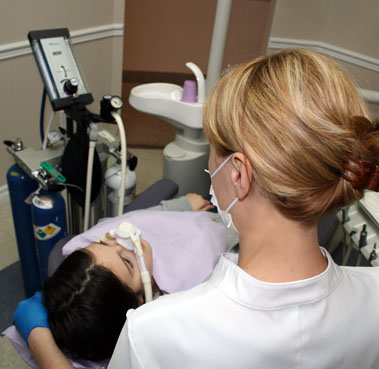Laughing Gas

Nitrous Oxide
More commonly referred to as laughing gas, is a form of inhalation sedation regularly used in dental offices. Laughing gas is simply a gas that you breath in. It is a mixture of nitrous oxide and oxygen.
Laughing gas is primarily used by dentists to alleviate tension and anxiety in their patients. Moments after putting the mask over your nose you will begin breathing in nitrous oxide which will almost instantly make you feel completely relaxed. You may even find that you have a smile on your face. You will experience a feeling of lightheadedness, well-being and a warm sensation.
The Advantages of the Nitrous Oxide Sedation
Nitrous Oxide works rapidly, the relaxation develops after 2-3 minutes. The depth of sedation can be altered from moment to moment, allowing the clinician who administers the gas to increase or decrease the depth of sedation (unlike other sedation techniques) Nitrous Oxide can be given for the exact time span it’s needed for. it can be switched off when not needed.
There is no “hangover effect”, the gas is eliminated from your body within 3-5 minutes after the gas supply is stopped. You can safely drive home and don’t need an escort, as well as you can resume your normal daily activities. Sedative pills or intravenous sedation, on the other hand require you to be escorted to and from the dental office. Nitrous oxide sedation is very safe.
Nitrous Oxide minimizes severe gauging and is safe for young children and medically compromised patients.
There is a safety mechanism in the delivery unit that doesn’t’t allow overdose and nitrous dioxide is always delivered mixed with oxygen. The machines used today have a built-in safety features preventing accidental overdose.
Who shouldn’t use Nitrous Oxide (and why)
- Some patients may not feel comfortable with the effects of laughing gas, they might be afraid to lose control
- Some patient may become nauseated
- Patients who cannot breathe through their nose
- The mouth breathers
- Patients with emphysema, MS, cold or upper respiratory infections, and with breathing difficulties
- Patients who are claustrophobic
- Very rarely, for some patients it is not possible to achieve adequate sedation with permissible and safe concentration of nitrous oxide.
We are, however happy to offer our patient alternative methods of sedation.
There is no know allergy to Nitrous Oxide. Should not be administered to patients who are claustrophobic or un abel to breath through their nose.
How It Is Done
A small, soft rubber inhaler will be placed over your nose. First you will breathe in 100% oxygen for about 5 minutes. Then the dentist will gradually increase the concentration of Nitrous Oxide (but always mixed with oxygen) until desired and comfortable level is achieved.
You will feel light headed at first, then gradually you will experience the feeling of warmth. It’s common to feel numbness in your toes and fingers. Which will pass as soon as the administering of Nitrous Oxide ceases.
At the conclusion you will receive 100% oxygen for minimum of 5 minutes. At that time you will feel absolutely back to normal.
“Laughing Gas” Is Highly Effective In:
- Management of mild to moderate levels of dental anxiety.
- Patients who have strong gauging reflex - it can be effectively eliminated or minimized with Nitrous Oxide.
- Apprehensive patients with medical problems like High Blood Pressure, asthma epilepsy.
- Patients with history of heart attack or angina pectoris, as Nitrous Oxide helps the patient relax and relieves stress.